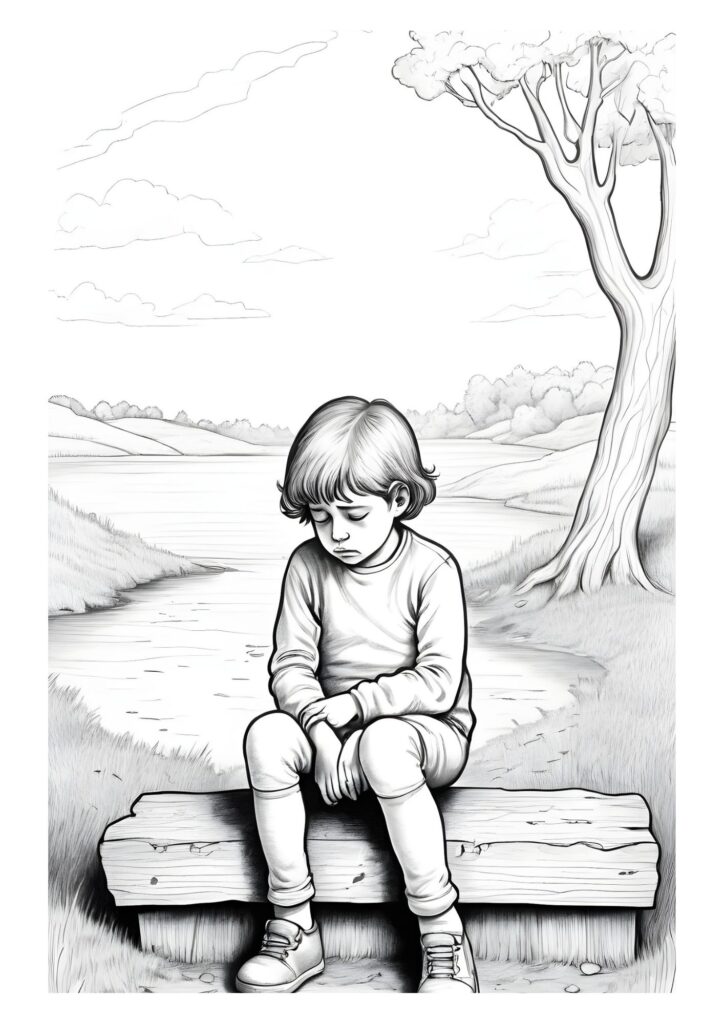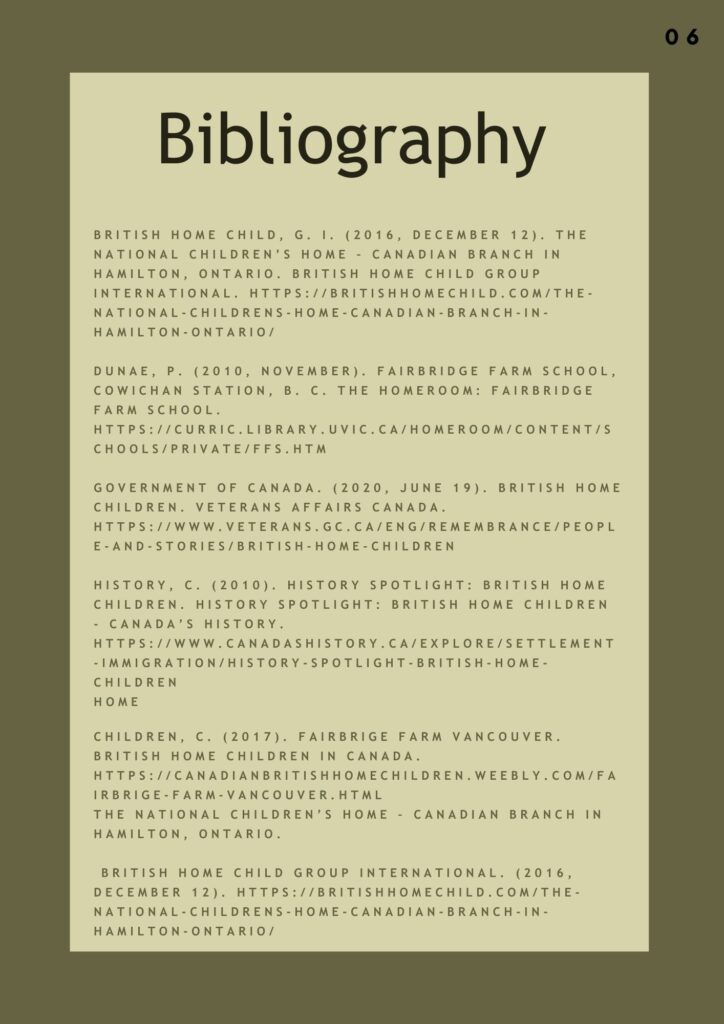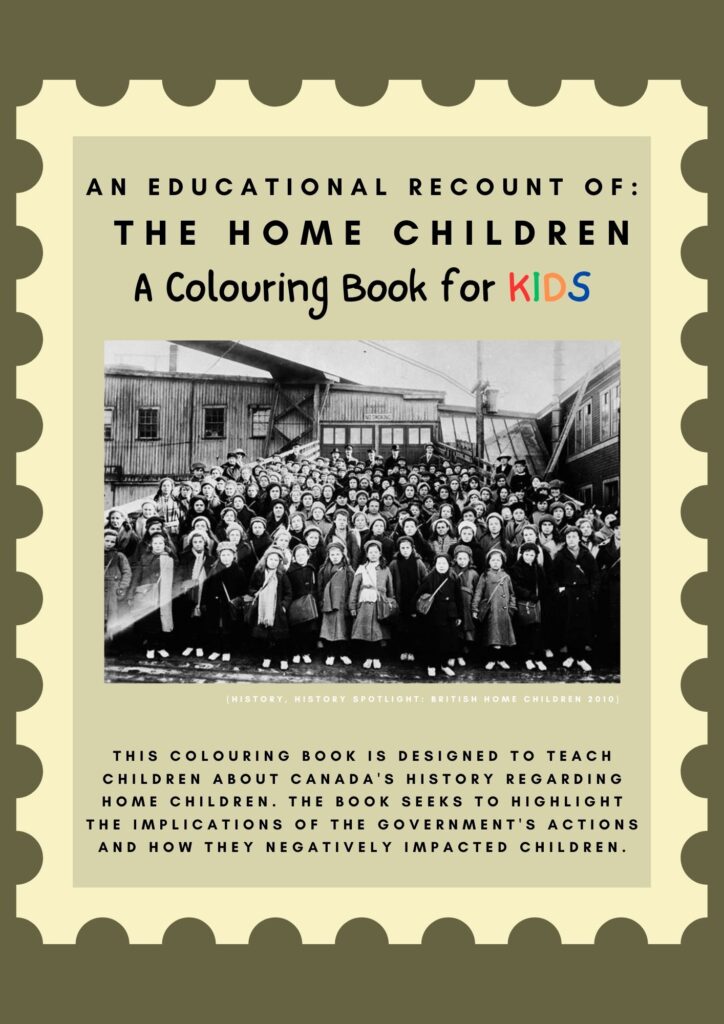This colouring book is designed to teach children about Canada’s history regarding home children. The book seeks to highlight the implications of the government’s actions and how they negatively impacted children.
The colouring book initiative was inspired by a shared goal to bring attention to the history of the movement of Home Children from the United Kingdom to Canada. The project explored the complex experiences of Home Children via art, with the goal of offering an interesting educational resource for audiences of all ages.
The book explores the long history and data around this subject by utilising digital archives, historical papers, and secondary literature. The content of the colouring book was inspired by and built upon the moving stories discovered in old photographs, personal letters, and other sources.
The selection and discovery of Home Children’s profiles was essential in determining the book’s overall theme. It was essential that a series of profiles that captured the many journeys of these kids—from leaving the UK to starting over in Canada—with an acute attention to historical detail and accuracy. A thorough representation of this historical phenomena was ensured by the careful selection of each profile to emphasise various facets of the migrant experience.
Utilising design, we sought to create an engrossing recount of Home Children’s experiences that struck a chord with readers by fusing historical context with interactive elements. Bringing each profile to life with careful investigation and reflective writing, enticing young readers to go on an empathetic and understanding journey.
In respect to the design and planning process of this book, we decided to reference our in-class reading about “Project management for the digital humanities”(Foster, 2024). Using this guide, we were able to effectively split up tasks and assign specific roles to ensure that the project creation was smooth sailing. Following the 5-phase plan truly made our jobs easier as it is often difficult to try and coordinate when completing group assignments. The splitting up of tasks and the early assignment of duties ensured that we both knew what and when things needed to be done.
That being said, when completing the project, we indeed faced several difficulties. To start, we found it somewhat difficult to ensure the information was written and transmitted in a way that was easily understood by children but did not take away from the significance of the matter itself. Obviously, the home children programs were incredibly harmful and exploited thousands of innocent children, but it also is significant to mention that since this is a book geared towards children, we couldn’t go into too much depth about the unethical reality of the situation.
Additionally, another issue that was posed for us was trying to ensure that the historical data we used was accurate. Using our required reading from class, “The Archive is not An Archives: Acknowledging the Intellectual Contributions of Archival Studies,” we were able to understand that like Caswell explains, it is important to use archival data within one’s research (Caswell, 2016). Unlike online articles and recounts, archives expose the facts from a first-hand perspective. It is extremely important to consider and extract information from archives as it will prove to be the most accurate and uncover new truths. That being said, when interpreting the archival data we also kept in mind the concept of “fixity” as described within our required reading, “What is Fixity, and When Should I be Checking It?” (Stefano et al., 2014). From this reading, we understood that when interpreting data we must check if it is fixed, to ensure we are receiving real, and accurate truths. While we were not uploading or transferring data ourselves, we did try to ensure that we inspected the sources we were using closely to guarantee that they were in their original, most authentic form.
Another issue we ran into was handling printing logistics. We had originally planned to send the book to an online printing service that would ship the book, but upon the completion of the colouring book, we realized we did not have enough time for it to be shipped. That being said, we overcame that small road bump by finding an alternative printing service.
Thankfully, we were able to overcome these challenges with communication and determination. We overcame the difficulties of the creative process by utilizing each another’s assets and talents, and ensuring that we were assigned aspects of the project that best aligned with our strengths…which consequently ensured we finished the colouring book!
This colouring book will serve as a valuable tool for education and memory in addition to being a symbol of their commitment and research abilities. The book resonated with audiences of all ages because it provided an innovative and engaging method of teaching history while also fostering empathy and understanding for the experiences of Home Children.
This joint project was very fun to partake in and we hope that through it, new generations will be exposed to the harsh truths surrounding Canada’s history interactively and creatively. We hope we brought the stories of the Home Children to life through our research, narrative skill, and creative inventiveness, ensuring that their legacy lives on in readers’ hearts and minds. The colouring book invites us to go on a compassionate and educational trip, serving as a tribute to the healing power of storytelling and human connection.
Sources and Readings used:
Caswell, M. (2016, August 4). “‘the archive’ is not an archives: On acknowledging the intellectual contributions of archival studies.” eScholarship, University of California. https://escholarship.org/uc/item/7bn4v1fk
Foster, K. (2024). About PM4DH. PM4DH: Project Management for the Digital Humanities. https://scholarblogs.emory.edu/pm4dh/
Stefano, P. (2014). What is fixity, and when should I be checking it?. What is Fixity, and When Should I be Checking It? https://www.digitalpreservation.gov/documents/NDSA-Fixity-Guidance-Report-final100214.pdf












